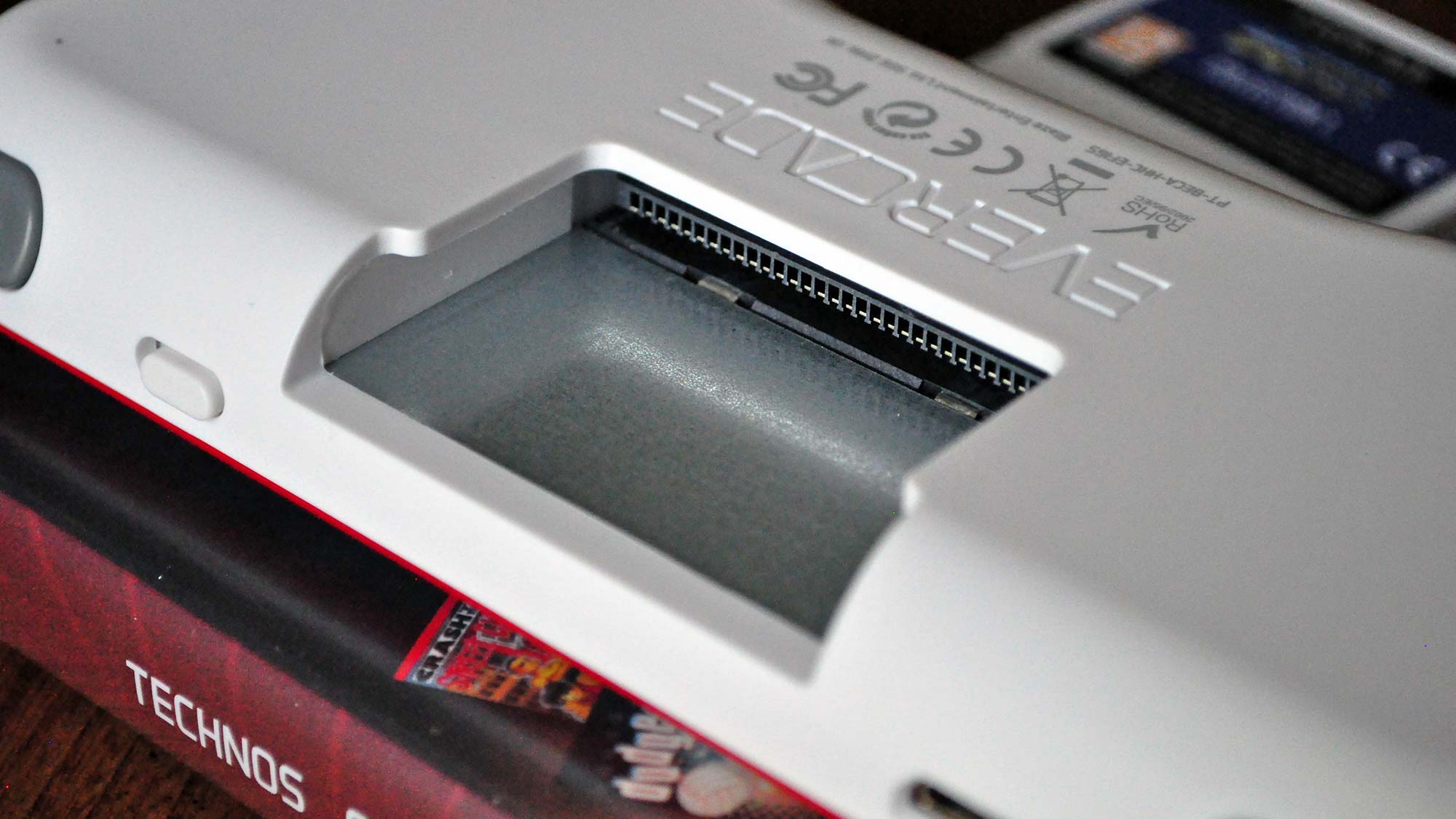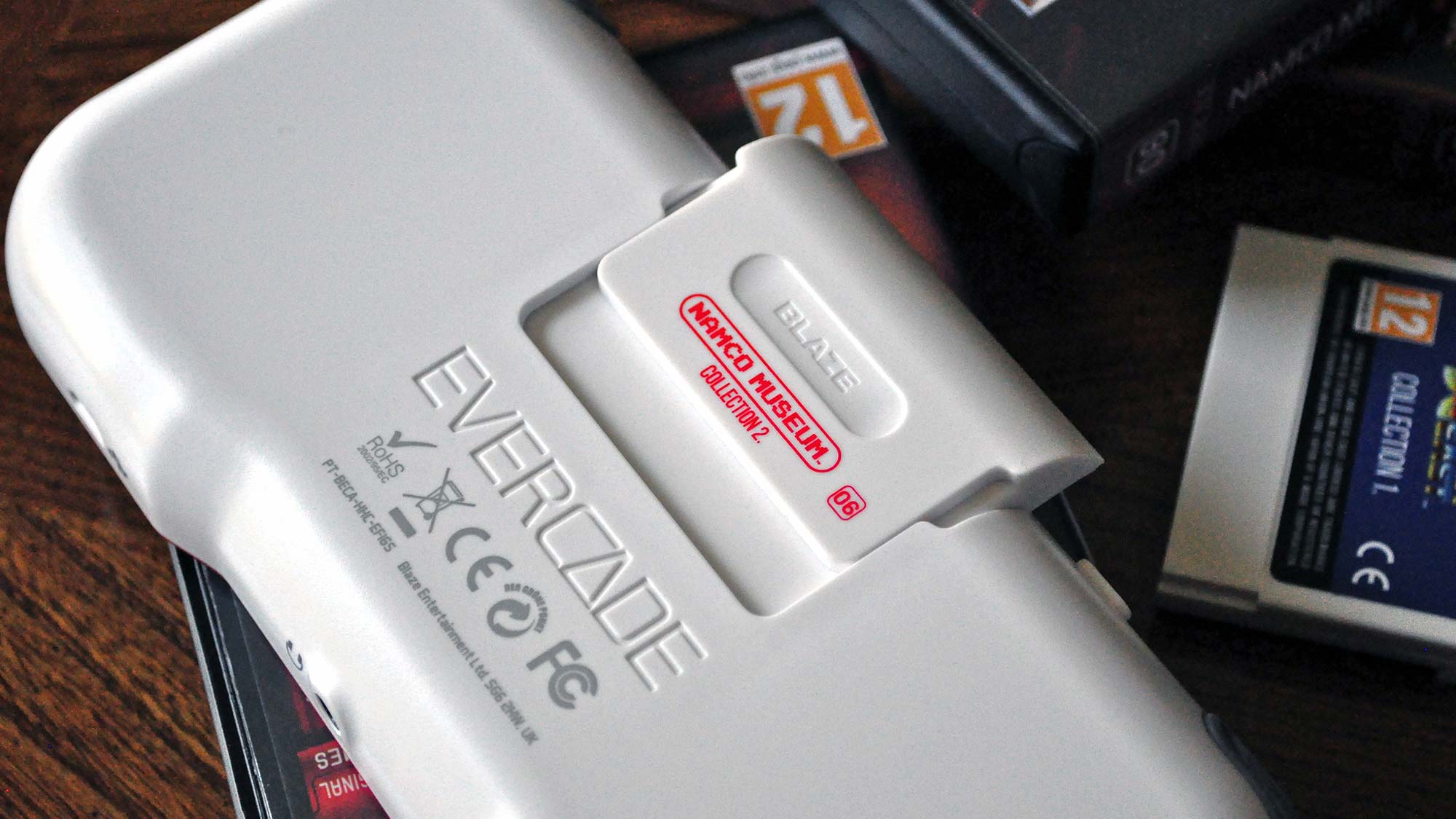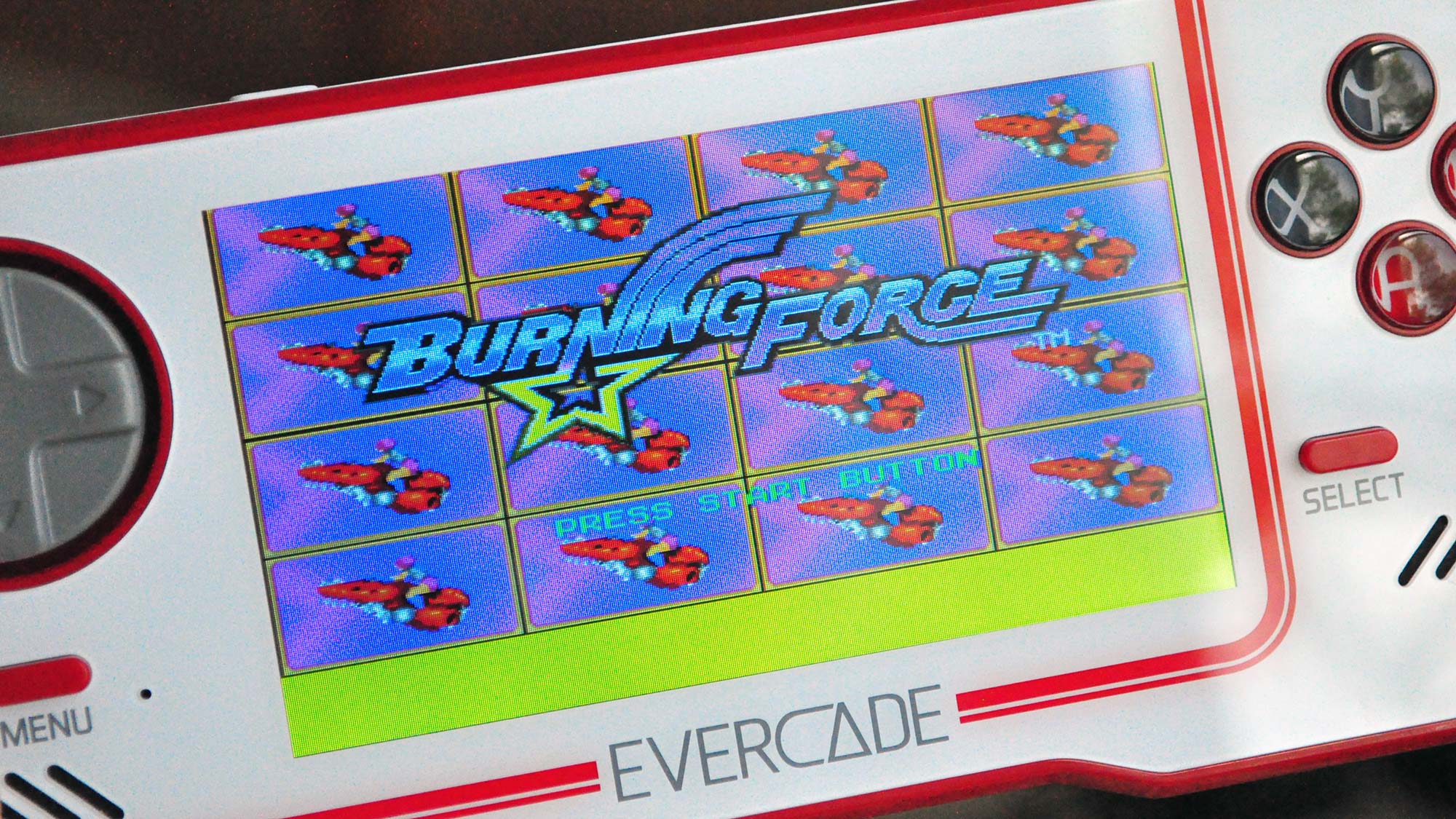Tom's Guide Verdict
If you’re nostalgic for old-school, cartridge-based handhelds and want an easy, affordable way to experience some of your favorite classics again, the Evercade is worth a look. Just don’t expect the highest-fidelity experience, or a perfect roster of games.
Pros
- +
Affordable
- +
Good emulation
- +
Controls feel great
- +
HDMI-out for external displays
Cons
- -
Middling design
- -
Limited display options
Why you can trust Tom's Guide
The Evercade doesn’t connect to Wi-Fi. It doesn’t have a touch screen, and its games come on cartridges; they’re not downloaded or played off an SD card. You won’t even find an analog stick on this handheld.
It seems like the Evercade shouldn’t exist in 2020, but exist it does. And those features it lacks aren’t deficiencies; they’re intentional, because the Evercade is designed to be a haven for retro gamers, based around simplicity and accuracy at an affordable price. Just how affordable? Try $80.
That low price might conjure up mental images of shoddily built plug-and-play systems with hundreds of ROMs and horrendous emulation. But the Evercade feels solid, and runs these games smoothly on the whole. It’s not perfect. You’re likely to encounter some control-mapping issues, depending on what you play. And of course, the Evercade is limited only to those classics released for it, which means the finest first-party titles from your favorite old consoles will be notably absent. But overall, the Evercade mostly succeeds as an effortless, inexpensive way to dip your toes into classic gaming on the go.
Editor's note: Blaze Entertainment has issued a downloadable firmware update that fixes the control-mapping bugs mentioned here that plagued a number of games in the Evercade's library. In response to that, we've updated this review and bumped the score from 3.5 to 4 out of 5.
Evercade price and availability
The Evercade went on sale May 22, and is available at Amazon. The system comes in two different editions. There's a Starter pack, which includes the handheld and the Namco Museum Collection I cartridge for $80/£60. You can also get a Premium pack, which includes the aforementioned Namco cartridge, as well as Atari and Interplay collections, for $100/£80.
Including the ones that ship with the system, there’s a total of 10 cartridges available at launch from a range of publishers, including Data East and Technos, as well as indie outfits like Piko Interactive and Mega Cat Studios. Each cart features anywhere from 6 to 20 games, but all cartridges retail for the same $20/£15. Games are grouped in collections by publisher, which is a logical way of organizing things.
If I was buying an Evercade today, I’d be somewhat worried about the number of cartridge releases I can expect going forward. Blaze Entertainment says at least three more will drop by the third quarter of the year: two Atari Lynx collections, as well as one dual-game pack featuring Xeno Crisis and Tanglewood. These are new, crowdfunded games that have actually been released on Sega Genesis cartridges, as well as modern platforms, like the Nintendo Switch.
Get instant access to breaking news, the hottest reviews, great deals and helpful tips.
Evercade design and hardware
Somewhere between a PSP and PS Vita in terms of size, but thicker than both, the Evercade isn’t exactly the most slender or attractive portable system. There’s a sheet of glossy plastic protecting the 4.3-inch LCD display and the entire face of the device, while the rest of the body is clad in a matte plastic shell that wouldn’t have felt out of place on an original Game Boy.
You’ll find red accents throughout — a stripe strewn around the screen, as well as a beveled edge that joins the front and back — that lend an appropriate old-school arcade aesthetic. There are volume keys on the bottom-left edge, a power slider up top, a headphone jack, a microUSB port for charging and, perhaps most surprising of all, a mini HDMI port that will let you output gameplay to a TV at 720p resolution.
I could complain that there’s a distinctly budget feel to the Evercade’s appearance, and all the plastic on plastic. But this is a budget device, and so I can’t really fault it for that. Besides, in spite of any knocks on the design, the controls themselves actually feel excellent.
I love how large the Evercade’s circle-style D-pad and buttons are, and that the shoulder buttons are clicky, but not stiff. The D-pad especially shines. It's precise like you’d want it to be, but also has the proper degree of give, allowing you to change directions fast. It actually reminds me of the Sega Saturn’s D-pad, which is high praise indeed.
While it's comfortable to game on the Evercade for long stretches of time, I have two gripes. First, the display is pretty underwhelming. The issue isn’t so much the screen's size, but how easily colors shift and luminosity fades if you hold the Evercade at an oblique angle. It also could stand to be a bit brighter. For what it’s worth, the system delivered about 4.5 hours of use from its 2,000-mAh battery while set to the highest of its three brightness options, which is in line with Blaze’s estimates.
The other issue pertains to inserting and removing cartridges from the Evercade, which is more daunting than it should be. Unlike cartridges in handhelds you might’ve played back in the day, the Evercade’s carts sit flush with the back of the system when inserted. This creates a clean look, and is pretty clever, since Blaze has taken the liberty of printing the cartridge’s contents and publisher logos on the back of each one for easy identification. But this design presents a problem when it comes time to switch a cartridge out.
The carts don’t have any ridges on them, save for a shallow divot that barely accommodates your thumb, and they sit incredibly snugly in their slot. As such, they’re a pain to pry out. Blaze says it’s aware of that problem, and has tweaked the design of the slot on the Evercade's final production models. Fortunately for us, the slot on our pre-production unit seemed to become more pliable with ongoing use.
Finally, while it may seem silly to review a system’s packaging, the fact of the matter is that Blaze clearly hopes that customers will be proud of their Evercade libraries, and will treat the cartridges, boxes and manuals as collectibles in their own right. Bearing that in mind, I couldn’t help but notice that the cases felt rather flimsy the first time I cracked one open. The box art isn’t especially pretty either, though I commend Blaze’s thoughtfulness to print a brief background on the publisher in question, as well as blurbs explaining the games, inside every booklet.
Evercade performance
At the heart of the Evercade is a 1.4GHz, quad-core processor, and it runs emulators that Blaze has either licensed or custom-built for the Evercade. As it stands now, these are simply NES, SNES and Genesis emulators. The Evercade plays the home ports of arcade titles like Pac-Man and Double Dragon, rather than their original arcade counterparts.
Generally speaking, these games run as well as you remember, which is perhaps the Evercade’s finest achievement. While some critics have reported audio glitches that Blaze is reportedly working to sort out, I didn’t encounter any issues with sound in my testing. Whatever input lag there might be is imperceptible, and these games look sharp enough, albeit not stunning, on the Evercade’s 480x272 display.
Top Racer — a retitled version of SNES classic Top Gear — moves as swiftly as you’d hope for an old sprite-scaling arcade racer, and the cars themselves handle responsively. Likewise, I found myself humming the theme to Namco’s Pac-Attack after I spent hours immersed in that addictive puzzler. The Evercade does a convincing job of imitating the SNES’ audio signature, at least through its tinny little speakers.
In fact, the only serious frustration I encountered while gaming on the Evercade for this review was the way in which it bungled the control schemes for some titles. With Top Racer for example, none of the game’s four controller configurations fully corresponded to the proper inputs on the hardware. And in Double Dragon II, I had to press the B button — which is located to the right of A — to kick left, while A punched right.
Part of this confusion stems from the fact that the labels for the face buttons on the Evercade are switched from their positions on the SNES pad; specifically, A and B, as well as X and Y, are in opposite locations. Strangely, Blaze went so far as to reverse the mapping for the first pair of buttons on Top Racer, but not the second, resulting in some buttons doing what you'd expect them to, while others don't. A custom button-mapping feature built into the Evercade’s software could have gone a long way toward fixing this. Sadly, no such capability exists.
This is further complicated by the fact that the games themselves still display the original button prompts, and the full-color manuals that Blaze has so thoughtfully included alongside these cartridges aren’t always the most helpful. For example: The diagram in the booklet for Top Racer shows accelerate as the X button, but says nothing about where to find the brake.
Fortunately, Blaze has responded quickly to this criticism. Version 1.1a of the system's firmware, which you can download to a PC and install on the Evercade in a matter of minutes, solved the issues I encountered in both Top Racer and Double Dragon II. It seems that in both cases, the system is now ignoring button labels and has adopted a mapping scheme based solely on button position, which is far more intuitive. The fact Blaze moved swiftly to push this update out in such close proximity to the handheld's release is a very encouraging sign that the company is listening, and hopefully, this means your favorite title in the Evercade library will also play the way it was intended to.
Evercade software and features
Upon booting up the Evercade, you’re greeted with a simple menu that allows you to scroll through all the games on whatever cartridge is inserted into the system. The interface isn’t ugly, but it doesn’t look like much thought went into it either, as it’s difficult to see all the titles available to you at a glance.
This isn’t like Nintendo’s Classic series, or the Sega Genesis Mini, where you can opt for an expanded view of many boxes at once, or sort them based on your preferences. You just scroll through one game at a time, which can be grating, considering that some of these collections contain up to 20 titles.
A Menu button below the D-pad provides quick access to saving and loading states, and there are 100 save state slots available per game, which is as amusing as it is excessive. Unfortunately, however, the Evercade doesn’t offer much in the way of display options — just the choice of playing a particular title in its original size, or widened to fit the 16:9 aspect ratio of the panel. There are no options for scanlines or filters of any sort, which will likely irk more discerning retro gaming aficionados.
The inclusion of a 16:9 screen on the Evercade is a bit of a head-scratcher to begin with, once you consider that this is a handheld primarily designed to play 4:3 games. That said, newer titles, like Xeno Crisis, may take advantage of the display’s full width, and there’s nothing stopping Blaze from releasing arcade ports in the future that may require bespoke, nonstandard aspect ratios.
Additionally, while you’ll find two-player modes in many of the games released for the Evercade, there’s currently no way to play with a friend. However, Blaze states that it could eventually offer a future console with multiplayer capabilities, and that this device could incorporate the very same cartridges as the Evercade.
Verdict
In spite of a few foibles, the Evercade is still a compelling package for retro gaming fans. Blaze’s priorities are in order here. The Evercade skips features that only hardcore, uber-serious retro gamers are sure to miss, and adopts a cheaper design to achieve a lower price. Yet, in spite of that, the games here all run well, the emulation is high-quality and the actual controls themselves feel excellent.
In fact, the Evercade’s most glaring flaw isn’t really a fault of the system; it’s the fact that a console like this, from a third-party manufacturer, is naturally going to exclude games from the likes of Nintendo, Sega, SNK and Hudson that defined the home consoles on which they appeared. Because you can’t add games to the Evercade yourself, you’re essentially beholden to whatever cartridges come out, and who knows how many that will be, when all is said and done?
Until Blaze drops a collection with a title or several that you really want to play, picking up an Evercade might not make much sense. In fact, there’s nothing in the system's 120-game library that speaks to me, personally. That said, if you see something you like, the Evercade is a low-risk investment that should put a nostalgic grin on your face.
Adam Ismail is a staff writer at Jalopnik and previously worked on Tom's Guide covering smartphones, car tech and gaming. His love for all things mobile began with the original Motorola Droid; since then he’s owned a variety of Android and iOS-powered handsets, refusing to stay loyal to one platform. His work has also appeared on Digital Trends and GTPlanet. When he’s not fiddling with the latest devices, he’s at an indie pop show, recording a podcast or playing Sega Dreamcast.








